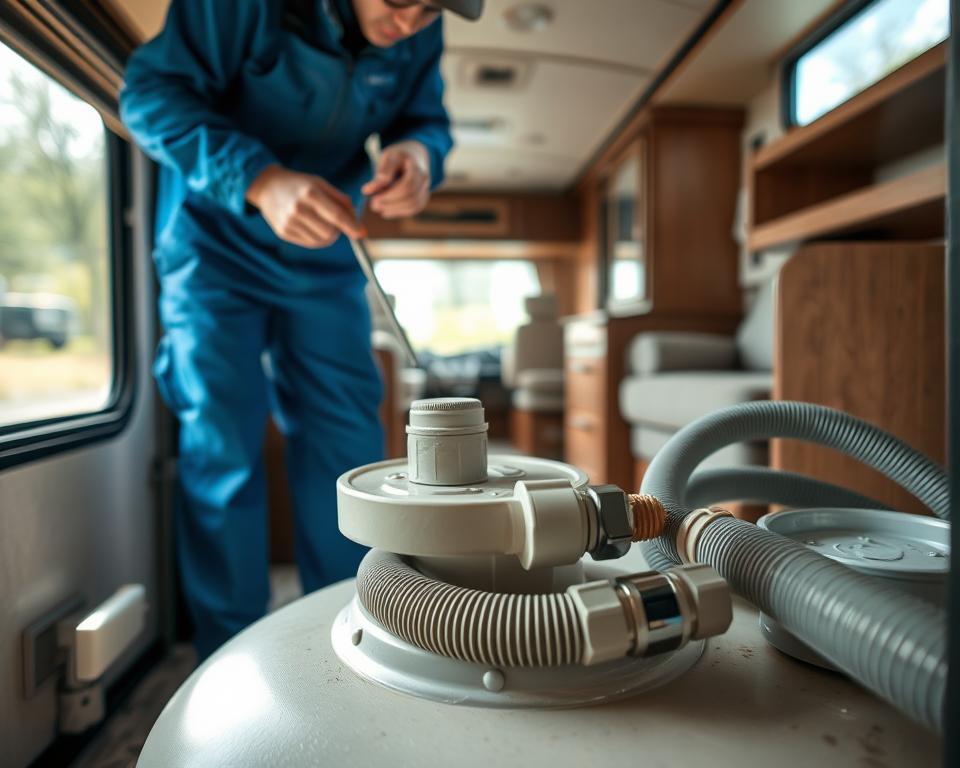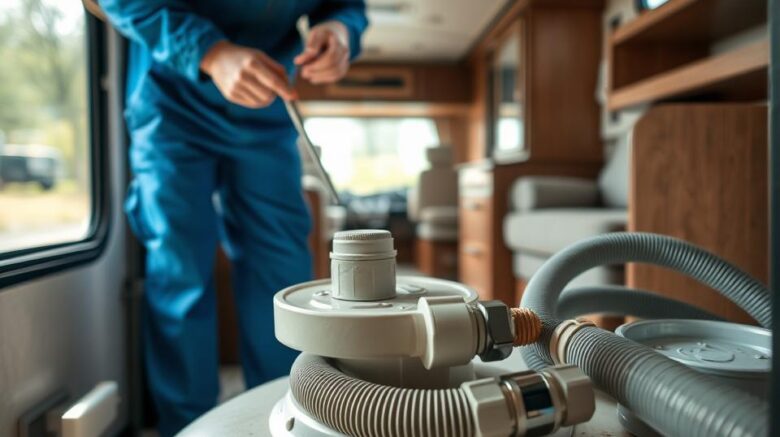RV Sewage Tank Pumping: Key Upkeep Guidelines
Think about the fallout from overlooking your RV’s septic system. Numerous campers feel intimidated by tank draining. However, understanding these upkeep steps is essential. Such measures keep your trips worry-free and prevent costly fixes. Learning proper waste disposal is key to your septic health. Here are key pointers on mobile RV tank pumping with upkeep advice to ensure your system operates flawlessly.
Getting to Know Your RV’s Waste Setup
Every recreational vehicle features a septic setup. It consists of a black tank for toilet use, a gray tank for sinks/showers, plus a freshwater reservoir. Grasping how each part works is key to proper black tank servicing and overall system care.
A series of drain lines and vent pipes balance waste flow and airflow. A good grasp prevents clogs and nasty odors. It’s the foundation of a smooth camping experience.
Maintaining clear, working tanks requires routine effort. Monitoring fill levels and dumping when needed keeps odors at bay. Proper upkeep extends tank life and enhances every journey.
Why Routine Tank Pumping Matters
Routine sewage draining preserves functionality and hygiene. Waste buildup triggers odors and backups that ruin outings. A full tank can produce embarrassing backups. Such mishaps kill the fun on the road.
Neglecting tank emptying invites expensive fixes. Damage from neglect can shorten component lifespan. Regular pumping ensures seamless operation. It prevents unwelcome surprises and roadside emergencies.
Proactive servicing stops clogs. Dedicating effort to pumping reflects good RV stewardship. Your trips become more relaxing. A strict pumping routine lets you enjoy camping without septic concerns.
How Often Should You Pump Your RV Septic Tank?
Determining dump intervals needs careful thought. Common guidance suggests a 3–5-day window. Still, it varies with tank size and occupancy. Pinpointing the correct dump time is key for effective wastewater management.
Dump the black tank at about two-thirds capacity. It ensures good drainage and cuts down on odors. Skipping this leads to blockages and smells that spoil the trip.
Various factors influence dump frequency, such as
- Number of people on board
- Length of stay
- Type of waste generated
- Tank capacity
Scheduling prevents on-the-road crises. Sync with any public dump station hours. Knowing your patterns predicts when to dump.
| Usage Scenario | Pumping Frequency |
|---|---|
| Weekend Getaway (2 people) | Every 3–4 days |
| Long Stay, Four to Six Occupants | Every 2–3 days |
| Seasonal Living (2–4 people) | Weekly or Bi-Weekly |
Monitor fill levels and usage patterns. Staying attentive guarantees a pleasant trip.

Proper Tank Dumping Techniques
Proper methods stop odors, clogs, and expensive repairs. Begin with the black tank to avoid cross-contamination. This prevents dirty water from fouling the clean.
Using a high-quality hose minimizes leaks and ensures smooth dumping. Secure all fittings firmly to avoid leaks. After emptying, flush the black tank with plenty of water. It clears lingering waste for a cleaner tank.
Scout dump spots along your route. This preparation streamlines your dump routine.
In short, follow these key steps for efficient dumping:
- Empty the black water tank first.
- Use a top-quality sewer hose.
- Flush the black tank thoroughly after emptying.
- Plan your dump station locations.
Following these guidelines simplifies black tank maintenance.
Proper Use and Maintenance of Your RV Tanks
Grasping correct handling of black and gray tanks ensures system health. Maintain a bit of water in the black tank to aid waste decomposition.
Refrain from disposing non-biodegradable items. Always use RV-safe toilet paper to prevent clogs. Inspect tanks often to catch problems early.
Adding treatments now and then improves septic service. These products balance enzymes and bacteria for efficient decomposition. Such measures keep your tanks operating at their best.
- Check for leaks and damage often.
- Apply RV-specific chemical treatments.
- Keep vents clear to avoid odors.
Adhering to these practices safeguards your system. You’ll enjoy more worry-free trips.
How to Pump Efficiently
Successful pumping requires precision and a clear procedure. It’s essential to use designated dump stations. Understanding volume limits prevents spills on the go.
Monitoring levels guides your dump schedule. Routine scheduling preserves your septic system and travel enjoyment. Setting a dumping schedule improves system efficiency.
Flush well after every emptying. It ensures each dump is cleaner than the last. Such tactics keep your rig in top shape and improve your travel experiences.
Avoid These Septic System Errors
Maintaining your system is vital for uninterrupted camping. Insufficient flushing causes solids to accumulate. Adequate water use breaks down solids efficiently.
Wrong flushables cause havoc—never flush wipes or towels. Avoid non-dissolvable products like feminine hygiene items. Such mistakes can damage plumbing and inflate repair bills.
Leaving the black valve open too early is a mistake. Open valves let water out but hold solids, causing residue. This ensures solids clear on each dump.
Knowing these pitfalls helps maintain efficiency. Avoiding them keeps your waste management reliable.
When to Seek Professional Septic Services
Recognizing the need for expert help extends tank life. Lingering smells can mean serious tank problems. Tanks that empty sluggishly hint at internal blockages.
Waste spillage near dump sites signals trouble. Such situations usually need high-pressure cleaning. Experts use specialized tools to clear stubborn clogs.
Regular expert check-ups safeguard tank health. Early intervention avoids expensive failures. Professional service ensures proper functionality.
Ongoing Septic Care Tips
Smart upkeep ensures lasting system performance. Regular pumping boosts system life and function. Routine rinses clear residue and stave off expensive breakdowns.
Implementing clean cycles safeguards tank health. Inspecting connections stops leaks before they spread. Opting for biodegradable products protects plumbing.
Keep these habits in mind:
- Stick to a pump-out timetable.
- Rinse often to remove solids.
- Sanitize twice a year.
- Inspect parts frequently for wear and tear.
Proactive care delivers worry-free travel. Through consistent upkeep, you’ll enjoy travel free from waste worries.
Conclusion
Effective RV septic maintenance is crucial for a pleasant experience. Understanding operation and following guidelines prevents headaches. Regular black tank maintenance improves efficiency. It enhances every mile.
Consistent inspections and care deliver trouble-free trips. This reliability supports every outing. These routines prime your rig for future rides. So you can focus on making memories, not dealing with tanks.
